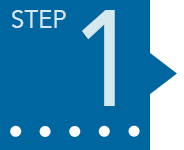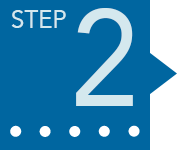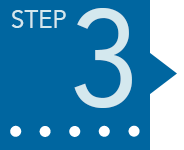Improving Your Vision With Cataract Surgery
Three easy steps to clearer vision
The only treatment for cataracts is to have the cataractous lens removed surgically. Fortunately, cataract surgery is one of the most common and safest surgical procedures in the United States with excellent results6. Ninety-five percent of cataract surgery patients in the U.S. experienced improvements in their vision post-cataract surgery and 90 percent have 20/40 vision or better without glasses!7
Terms To Know
- phacoemulsification: The “technical term” for cataract surgery when a probe is inserted into a small incision in the eye, sound waves break up the cataractous lens so it can be removed and replaced with and an intraocular lens implant.
- intraocular lens implant (IOL): The artificial replacement lens, chosen in accordance with your glasses prescription, that replaces the natural lens during the phacoemulsification procedure.

Step 1: Cataract Removal
In this first step, your surgeon will use a process called phacoemulsification. He will make a small incision in the cornea and insert a probe, about the size of a pen tip, which uses sound waves to break up the cataract, then suction it out to prepare for step 2.

Step 1: Cataract Removal
In this first step, Dr. Parker or Dr. Stuckenschneider will use a process called phacoemulsification. He will make a small incision in the cornea and insert a probe, about the size of a pen tip, which uses sound waves to break up the cataract, then suction it out to prepare for step 2.

Step 2: IOL Insertion
Now that the cataract lens is removed, your surgeon uses a specialized instrument to position the new, artificial intraocular lens. The IOL is actually rolled up inside the instrument so it can be inserted into the lens capsule through the tiny incision. The lens flattens inside the capsule and the haptics, or “arms,” unfold to keep the IOL in the proper position.

Step 2: IOL Insertion
Now that the cataract lens is removed, Dr. Stuckenschneider or Dr. Parker uses a specialized instrument to position the new, artificial intraocular lens. The IOL is actually rolled up inside the instrument so it can be inserted into the lens capsule through the tiny incision. The lens flattens inside the capsule and the haptics, or “arms,” unfold to keep the IOL in the proper position.

Step 3: New Vision
Now that the cataract is removed and a clear IOL is in place, the light needed to focus images on the retina can once again enter the eye providing clear vision. After surgery you may feel as if you have “new eyes” and are able to see colors more vividly and objects more clearly than you have in years.

Step 3: New Vision
Now that the cataract is removed and a clear IOL is in place, the light needed to focus images on the retina can once again enter the eye providing clear vision. After surgery you may feel as if you have “new eyes” and are able to see colors more vividly and objects more clearly than you have in years.
Determining Which IOL Best Suits Your Lifestyle
Costs Associated with Cataract Surgery
Cataract surgery is covered by insurance or Medicare and is applicable to your deductible. The surgical aspect of correcting your cataracts is typically the same. However, advancements in IOL technology provide more options in the benefits you receive from your cataract surgery but incur out-of-pocket costs. You and your surgeon can discuss which IOL best fits your daily activities, vision preferences, and budget. The options are detailed below.
Standard Monofocal IOL: Traditional Technology
Monofocal IOLs are considered standard and do not incur out-of-pocket fees.
The standard IOL used in cataract surgery is a monofocal lens and is covered by insurance and Medicare. A monofocal lens corrects vision at one range, typically your distance vision. You would still need glasses for reading and possibly for distance if you have an astigmatism. Sometimes, monovision can be achieved with monofocal IOLs to gain some near vision.
- Covered by insurance and Medicare
- Corrects distance vision
- Corrects astigmatism
- Corrects intermediate vision
- Corrects near vision
- Incurs additional out-of-pocket upgrade fees
Monovision with a Monofocal IOL: Gaining Reading Vision
Monofocal IOLs are considered standard and do not incur out-of-pocket fees.
Monovision uses two different powers of monofocal IOLs to gain near vision. This is accomplished by using an IOL for distance in one eye (typically your dominant eye), and a different powered IOL for near vision in the other eye. Both eyes learn to work together to see objects at different distances. Not everyone can adapt to this blended vision and not every prescription is a candidate. Sometimes you can try monovision with contacts prior to cataract surgery. With this option, you would still need glasses to achieve your sharpest vision.
- Covered by insurance and Medicare
- Corrects distance vision
- Corrects astigmatism
- Corrects intermediate vision
- Corrects near vision
- Incurs additional out-of-pocket upgrade fees
Toric IOL: Two Conditions, One Solution
Toric IOLs are considered an elective upgrade and incur out-of-pocket fees of approximately $1000/eye*.
The toric IOL is an elective upgrade because it corrects two conditions with one solution. The advanced technology of this IOL corrects your cataract AND your astigmatism. With this option, you would still need glasses for reading.
- Covered by insurance and Medicare
- Corrects distance vision
- Corrects astigmatism
- Corrects intermediate vision
- Corrects near vision
- Incurs additional out-of-pocket upgrade fees
Multifocal and Toric Multifocal IOL: All Distances
Multifocal IOLs are considered an elective upgrade and incur out-of-pocket fees of approximately $2000/eye*.
The multifocal IOL is an elective upgrade and allows you to be less dependent on glasses for all distances: near, far, and in-between. You may experience glare and halos at night and difficulty in low lighting situations. With this option, glasses may still be needed for achieving your sharpest vision.
- Covered by insurance and Medicare
- Corrects distance vision
- Corrects astigmatism (multifocal toric)
- Corrects intermediate vision
- Corrects near vision
- Incurs additional out-of-pocket upgrade fees
Extended Depth of Focus (EDOF) & Toric EDOF IOL: All Distances
EDOF IOLs are considered an elective upgrade and incur out-of-pocket fees of approximately $2000/eye*.
The multifocal toric IOL is an elective upgrade and offers the same features as the multifocal IOL, but also corrects for astigmatism making you less dependent on glasses for all distances and refractive errors. You may experience glare/halos at night and difficulty in low lighting situations.
- Covered by insurance and Medicare
- Corrects distance vision
- Corrects astigmatism (EDOF toric)
- Corrects intermediate vision
- Corrects near vision
- Incurs additional out-of-pocket upgrade fees
Premium Accommodative IOL: Working Like Your Natural Lens
Accommodating IOLs are considered an elective upgrade and incur out-of-pocket fees of approximately $1600/eye*.
The accommodative IOL is an elective upgrade. This IOL is “hinged” to work in coordination with your eye muscles. The design allows the lens to move forward to focus at near and backward when focusing at a distance, much like your natural lens, providing varying distances and a continuous range of vision.
- Covered by insurance and Medicare
- Corrects distance vision
- Corrects astigmatism
- Corrects intermediate vision
- Corrects near vision
- Incurs additional out-of-pocket upgrade fees
Written By: Kimberley Bader, Patient Education Coordinator
Reviewed By: Shawn Parker, MD, FACS
Last Updated: January 26, 2020
SOURCES / REFERENCES:
1,† “Cataract surgery: replacing your cloudy lens.” Alcon, a Novartis Division, Web. Accessed April 3, 2017.
2,^ “Common Eye Disorders – Cataract.” Centers for Disease Control and Prevention (CDC), Web. Sep 2015. Accessed April 3, 2017.
3 “Facts About Cataract – Is cataract surgery effective?” National Eye Institute, Web. Sep 2015. Accessed April 3, 2017.
4 “What Are Cataracts? – Types of Cataracts” Alcon, a Novartis Division, Web. Accessed March 28, 2017
5 “Eye Health Information: Cataract” National Eye Institute (NEI), Web. Accessed April 3, 2017
6 “Treating Cataracts with Surgery – Understanding the Surgery” Alcon, a Novartis Division, Web. Accessed April 3, 2017.
7 “Wilmer Eye Institute: Cataracts FAQ – Prognosis” Johns Hopkins Medicine, Web. Accessed April 3, 2017.
8,~ “My Cataract Journey – Potential Risks and Complications” All About Vision, Web. Accessed March 28, 2017.
9 “Cataract Surgery: What is a secondary cataract.” American Optometric Association (AOA), Web. Accessed March 28, 2017.
![]()
